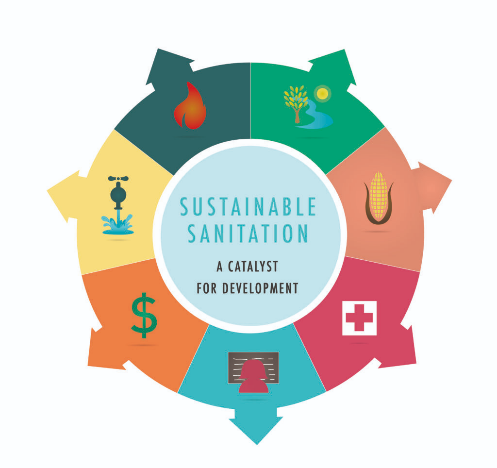Description

Figure 1: No Copyright Infringement Intended
Context
- Clean India Mission sanitation programme, aimed to provide every family with sanitation facilities, including toilets, solid and liquid waste disposal systems but its implementation still remains a challenge.
Background
- According to the World health organisation sanitation generally refers to the provision of facilities and services for the safe disposal of human urine and feces.
- In 2017, 45% of the global population (3.4 billion people) used a safely managed sanitation service.
- 31% of the global population (2.4 billion people) used private sanitation facilities connected to sewers from which wastewater was treated.
- 14% of the global population (1.0 billion people) used toilets or latrines where excreta were disposed of in situ.
- 74% of the world’s population (5.5 billion people) used at least a basic sanitation service.
- 0 billion people still do not have basic sanitation facilities such as toilets or latrines.
- Of these, 673 million still defecate in the open, for example in street gutters, behind bushes or into open bodies of water.
- At least 10% of the world’s population is thought to consume food irrigated by wastewater.
- Cropland in peri-urban areas irrigated by mostly untreated urban wastewater is estimated to be approximately 36 million hectares (equivalent to the size of Germany)
- Poor sanitation is linked to transmission of diseases such as cholera, diarrhoea, dysentery, hepatitis A, typhoid and polio and exacerbates stunting.
- Poor sanitation reduces human well-being, social and economic development due to impacts such as anxiety, risk of sexual assault, and lost educational opportunities.
- Inadequate sanitation is estimated to cause 432 000 diarrhoeal deaths annually and is a major factor in several neglected tropical diseases, including intestinal worms, schistosomiasis, and trachoma. Poor sanitation also contributes to malnutrition.
Sanitation and health
- Some 827 000 people in low- and middle-income countries die as a result of inadequate water, sanitation, and hygiene each year, representing 60% of total diarrhoeal deaths. Poor sanitation is believed to be the main cause in some 432 000 of these deaths.
- Diarrhoea remains a major killer but is largely preventable. Better water, sanitation, and hygiene could prevent the deaths of 297 000 children aged under 5 years each year.
- Open defecation perpetuates a vicious cycle of disease and poverty. The countries where open defecation is most widespread have the highest number of deaths of children aged under 5 years as well as the highest levels of malnutrition and poverty, and big disparities of wealth
Benefits of improved sanitation
Benefits of improved sanitation extend well beyond reducing the risk of diarrhoea. These include:
- reducing the spread of intestinal worms, schistosomiasis and trachoma, which are neglected tropical diseases that cause su ering for millions;
- reducing the severity and impact of malnutrition;
- promoting dignity and boosting safety, particularly among women and girls;
- promoting school attendance: girls’ school attendance is particularly boosted by the provision of separate sanitary facilities; and
- potential recovery of water, renewable energy and nutrients from faecal waste.
- A WHO study in 2012 calculated that for every US$ 1.00 invested in sanitation, there was a return of US$ 5.50 in lower health costs, more productivity, and fewer premature deaths.
Challenges
- In 2013, the UN Deputy Secretary-General issued a call to action on sanitation that included the elimination of open defecation by 2025. Achieving universal access to a basic drinking water source appears within reach, but universal access to basic sanitation will require additional e orts.
- The situation of the urban poor poses a growing challenge as they live increasingly in mega cities where sewerage is precarious or non-existent and space for toilets and removal of waste is at a premium. Inequalities in access are compounded when sewage removed from wealthier households is discharged into storm drains, waterways or landfills, polluting poor residential areas.
- Limited data available on this topic suggests that a large proportion of wastewater in developing countries is discharged partially treated or untreated directly into rivers, lakes or the ocean.
- Wastewater is increasingly seen as a resource providing reliable water and nutrients for food production to feed growing urban populations. Yet this requires:
- management practices that ensure wastewater is su ciently treated and safely reused;
- institutional oversight and regulation; and
- public education campaigns to inform people about wastewater use.
Steps taken via 10 year rural sanitation strategy
- The strategy has been prepared by the Department of Drinking Water and Sanitation (DDWS), Ministry of Jal Shakti, GoI in consultation with the State Governments and other stakeholders.
- It lays down a framework to guide local governments, policy-makers, implementers and other relevant stakeholders in their planning for Open Defecation Free (ODF) Plus status, where everyone uses a toilet, and every village has access to solid and liquid waste management.
- The strategy aims to sustain the behavioral change regarding sanitation that has been achieved under the Swachh Bharat Mission Gramin (SBM-G) and ensure that the focus is shifted to increasing access to solid and liquid waste management in the rural areas of the country.
- The 10-year strategy also demands focused intervention through capacity strengthening, IEC (Information, Education, and Communication), organic waste management, plastic waste management, and water management.
- Public financing has played an important role in the ODF journey but for the maintenance of toilets and infrastructure, the need is there for innovative models for sanitation financing.
- With regard to waste management elements, there will have to be a convergence of funds from the Centre, states, Panchayati raj institutions (PRIs) and alternative sources of financing, including private funds.














